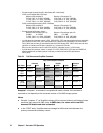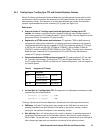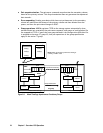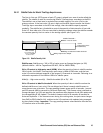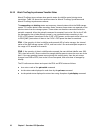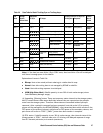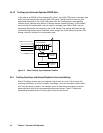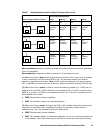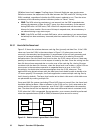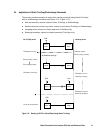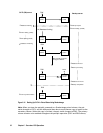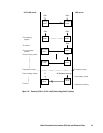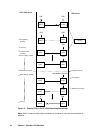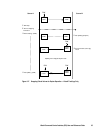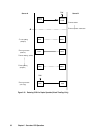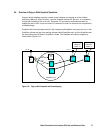
30 Chapter 2 Overview of CCI Operations
[4] When fence level is async: TrueCopy Async/Universal Replicator uses asynchronous
transfers to ensure the sequence of write data between the PVOL and SVOL. Writing to the
PVOL is enabled, regardless of whether the SVOL status is updated or not. Thus the mirror
consistency of the secondary volume is dubious (similar to “Never” fence):
PSUE: The SVOL mirroring consistency is not assured, but the PSUE suspended state
ensures the sequence of data for the CT group, thus data consistency is also assured
during PSUE state. At PSUE state, PVOL writes still complete and are also noted in a
bitmap for future transfer. Due to use of bitmap in suspend state, data consistency is
not assured during a copy state resync.
PAIR: If the PVOL and SVOL are both PAIR state, mirror consistency is not assured (may
be behind) but data consistency is assured (what has reached the SVOL is in the proper
order).
2.4.3.1 How to Set the Fence Level
Figure 2.12 shows the relations between redo log files (journal) and data files. If the S-VOL
takes over from the P-VOL in the status shown in Figure 2.12 (where two errors have
occurred), the secondary
host leaves data (V) unprocessed in the roll-back processing and
cannot be recovered completely. Therefore, the fence level of a redo log file must be
defined as data. Once the fence level is set to data, the P-VOL returns an error if data may
possibly be inconsistent when a write request is issued by the host. Since the writing into the
data file has not been executed due to a write error of the redo log file, the log file stays
consistent with the data file. However, when the fence level is set to data, a write I/O error
occurs even in the case where operation is suspended due to an error in the S-VOL.
Accordingly, the duplication becomes meaningless when the S-VOL takes over. Thus,
applications using paired volumes with the data fence level should be able to handle write
I/O errors properly. For example, the Oracle application creates multiple redo log files by
itself (three by default). The fence level can be set to data in this case in which disk errors
are permissible by creating multiple file.
Since most UNIX file systems (excluding JFS and VxFS) have no journal files, the fence level
should be defined as Never. When a takeover by the S-VOL occurs, fsck is executed on the
volume and the file system is cleaned up, even if the S-VOL is undefined at the secondary
host. The data that will be lost depends on how much differential data is contained in the
P-VOL when the S-VOL is suspended. During operation, error recovery should be performed
when the suspended status (PSUE or PDUB) is detected (when one error occurs).
Data (V)
Data (V)
Log (V)
Log (IV)
Primary Volume
Secondary Volume
Figure 2.12 Relation between Logs and Data in Paired Status



